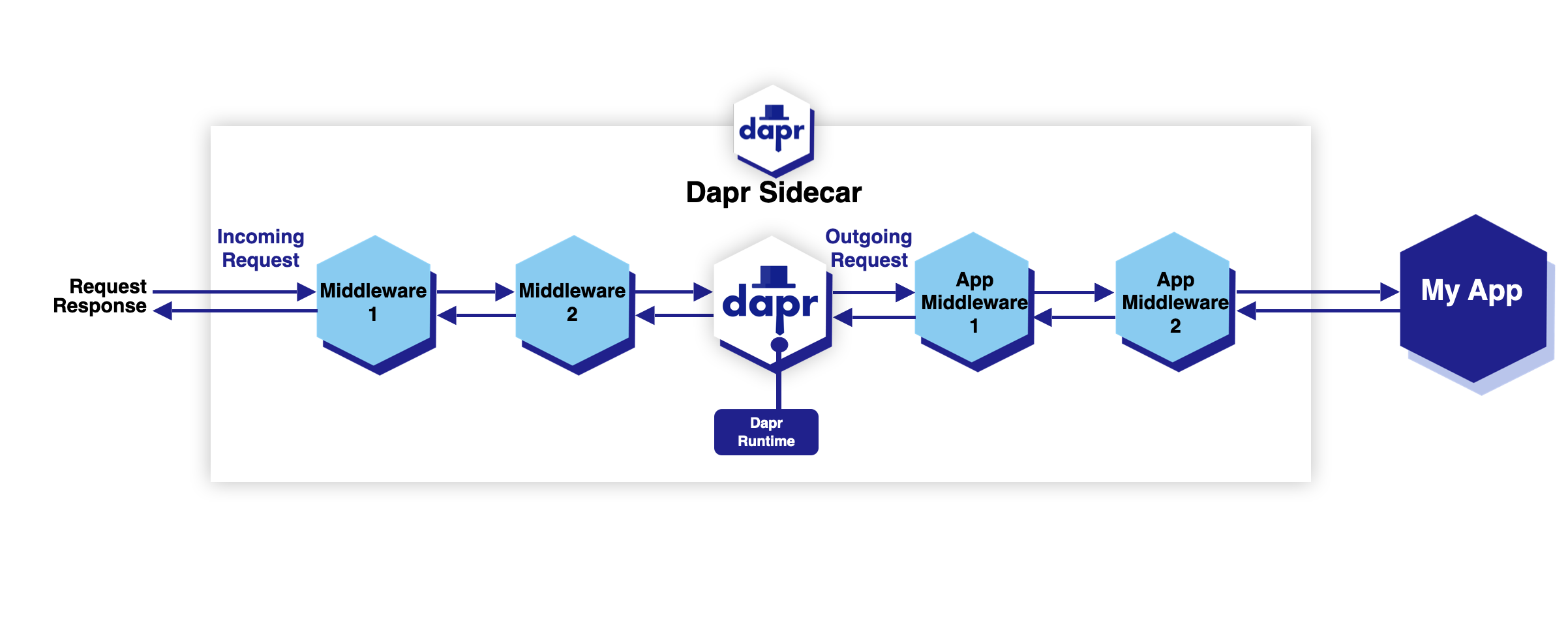The documentation you are viewing is for Dapr v1.15 which is an older version of Dapr. For up-to-date documentation, see the latest version.
配置中间件组件
Dapr 允许通过串联一系列中间件组件来定义自定义处理管道。您可以在以下两种场景中使用中间件管道:
- 基础模块 API - 在调用任何 Dapr HTTP API 时执行 HTTP 中间件组件。
- 服务间调用 - HTTP 中间件组件应用于服务间调用。
配置 API 中间件管道
启动时,Dapr sidecar 会为传入的 HTTP 调用构建一个中间件处理管道。默认情况下,管道由追踪和 CORS 中间件组成。可以通过 Dapr configuration 配置的其他中间件按定义顺序添加到管道中。该管道适用于所有 Dapr API 端点,包括 state、pubsub、service-invocation、bindings、secret、configuration、分布式锁等。
请求在路由到用户代码之前会依次经过所有定义的中间件组件,然后在返回给客户端之前以相反的顺序再次经过这些中间件,如下图所示。

在使用 httpPipeline 配置调用 Dapr HTTP API 时,HTTP 中间件组件会被执行。
以下配置示例定义了一个自定义管道,使用了 OAuth 2.0 中间件 和 大写中间件组件。在这种情况下,所有请求在转发到用户代码之前都通过 OAuth 2.0 协议进行授权,并转换为大写文本。
apiVersion: dapr.io/v1alpha1
kind: Configuration
metadata:
name: pipeline
namespace: default
spec:
httpPipeline:
handlers:
- name: oauth2
type: middleware.http.oauth2
- name: uppercase
type: middleware.http.uppercase
与其他组件一样,中间件组件可以在支持的中间件参考和dapr/components-contrib 仓库中找到。
配置应用中间件管道
在进行服务间调用时,您也可以使用任何中间件组件。例如,在零信任环境中添加令牌验证,转换特定应用端点的请求,或应用 OAuth 策略。
服务间调用中间件组件适用于从 Dapr sidecar 到接收应用(服务)的所有传出调用,如下图所示。

任何可以用作 HTTP 中间件的中间件组件也可以通过 appHttpPipeline 配置应用于服务间调用。下面的示例为从 Dapr sidecar(服务调用的目标)到应用的所有传出调用添加了 uppercase 中间件组件。
apiVersion: dapr.io/v1alpha1
kind: Configuration
metadata:
name: pipeline
namespace: default
spec:
appHttpPipeline:
handlers:
- name: uppercase
type: middleware.http.uppercase
相关链接
Feedback
Was this page helpful?
Glad to hear it! Please tell us how we can improve.
Sorry to hear that. Please tell us how we can improve.